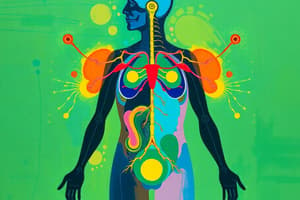Podcast
Questions and Answers
What is the primary purpose of osmoregulation in organisms?
What is the primary purpose of osmoregulation in organisms?
- To facilitate efficient nutrient absorption
- To enhance the process of respiration
- To maintain the balance of water and salts in the body (correct)
- To regulate body temperature during hibernation
Which mechanism primarily contributes to evaporative heat loss in animals?
Which mechanism primarily contributes to evaporative heat loss in animals?
- Countercurrent heat exchange
- Sweating or panting (correct)
- Thyroid hormone secretion
- Vasoconstriction
Which type of plants is best adapted to saline environments?
Which type of plants is best adapted to saline environments?
- Mesophytes
- Hydrophytes
- Xerophytes
- Halophytes (correct)
What role does the Antidiuretic Hormone (ADH) play in the body?
What role does the Antidiuretic Hormone (ADH) play in the body?
What is the state of dormancy during hot or dry periods called?
What is the state of dormancy during hot or dry periods called?
Which of the following is NOT a type of pathogen?
Which of the following is NOT a type of pathogen?
What is the function of countercurrent heat exchange in animals?
What is the function of countercurrent heat exchange in animals?
Which of the following processes is involved in thermogenesis?
Which of the following processes is involved in thermogenesis?
What is the primary function of hormones in the body?
What is the primary function of hormones in the body?
What occurs during upregulation of hormone receptors?
What occurs during upregulation of hormone receptors?
Which of the following endocrine glands is primarily responsible for insulin production?
Which of the following endocrine glands is primarily responsible for insulin production?
What benefit does brown adipose tissue provide in thermoregulation?
What benefit does brown adipose tissue provide in thermoregulation?
How do endotherms primarily maintain their body temperature?
How do endotherms primarily maintain their body temperature?
What role do receptors play in the hormone signaling process?
What role do receptors play in the hormone signaling process?
Which behavioral response is an example of thermoregulation in cold environments?
Which behavioral response is an example of thermoregulation in cold environments?
What is the consequence of downregulation of hormone receptors?
What is the consequence of downregulation of hormone receptors?
Flashcards are hidden until you start studying
Study Notes
Hormonal Homeostatic Control Pathways
- Hormones act as chemical messengers primarily produced in endocrine glands like the thyroid, pancreas, and adrenal glands.
- They circulate through blood or lymphatic systems to target cells with specific receptors.
- Endocrine glands directly secrete hormones into the bloodstream, unlike exocrine glands which use ducts.
- Receptors on target cells determine sensitivity:
- Upregulation increases receptor numbers, enhancing sensitivity.
- Downregulation decreases receptor numbers, reducing sensitivity.
- Signal transduction initiates cellular activity changes after hormone binding:
- Increased cellular activity example: insulin enhances glucose uptake.
- Decreased cellular activity example: anti-inflammatory hormones reduce inflammation.
Thermoregulation
- Thermoregulation maintains internal body temperature within an optimal range despite external changes.
- Endotherms, such as mammals and birds, produce body heat internally through metabolism.
- Structural adaptations for thermoregulation include:
- Brown adipose tissue generates heat from calorie burning.
- Increased mitochondria in cells boost energy and heat production.
- Insulation reduces heat loss via fur, feathers, or fat layers.
- Behavioral adaptations involve:
- Kleptothermy: sharing body heat with others.
- Hibernation: metabolic depression during winter inactivity.
- Aestivation: dormancy during hot or dry conditions.
- Torpor: short-term metabolic and temperature reduction.
- Physiological mechanisms function in thermoregulation:
- Vasomotor control adjusts blood vessel size to manage heat loss.
- Evaporative heat loss occurs through sweating or panting.
- Countercurrent heat exchange warms returning cooler blood.
- Thermogenesis produces heat, primarily during shivering or non-shivering states.
- Homeostatic regulation includes:
- Thyroid hormones influencing metabolic rate and heat production.
- Insulin affecting energy storage and metabolic processes.
Osmoregulation
- Osmoregulation controls water and salt balance to maintain homeostasis.
- Osmoregulators actively manage osmolarity (e.g., freshwater fish); osmoregulators remain isotonic to surroundings (e.g., marine invertebrates).
- Excretory systems, like kidneys, filter blood and balance water and salt.
- Behavioral adaptations may include seeking or avoiding water and altering activity or feeding.
- Physiological mechanisms:
- Kidneys regulate water and electrolyte balance by filtering and excreting urine.
- Homeostatic mechanisms involve:
- Antidiuretic hormone (ADH) promoting water reabsorption, reducing urine output.
- Plant osmoregulation characteristics include:
- Stomata for gas exchange and water loss control.
- Vacuoles for water storage and cell turgor maintenance.
- Cuticle minimizes water loss.
- Abscisic acid (ABA) closes stomata under water stress.
- Xerophytes are plants adapted to arid environments (e.g., cacti).
- Hydrophytes thrive in wet environments (e.g., water lilies).
- Halophytes are suited to saline environments (e.g., mangroves).
- Mesophytes are adapted to moderate conditions.
Infectious Disease
- Infectious diseases result from pathogen invasion, including bacteria, viruses, fungi, and parasites, and can be transmitted between hosts.
- Non-infectious diseases arise from non-pathogenic causes and are not transmissible, including genetic disorders, cancers, and lifestyle-related diseases such as heart disease and diabetes.
- Types of pathogens include:
- Prions: misfolded proteins responsible for neurodegenerative diseases (e.g., Creutzfeldt-Jakob disease).
- Viruses: infectious agents composed of genetic material encased in protein, requiring host cells for replication.
Studying That Suits You
Use AI to generate personalized quizzes and flashcards to suit your learning preferences.




